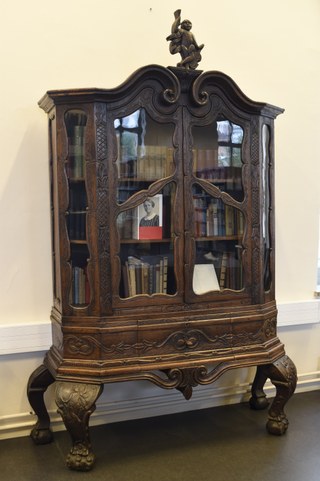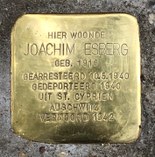A diaspora of books: ex-libris Suse Esberg
Who is Suse Esberg? And how did her books end up in Ghent – and eventually in the University Library collection?
A bookcase in the faculty library reunites Suse Esberg’s books, which feature her beautiful ex-libris. The book collection is testimony to the turbulent family history that inspired both author Willy Roggeman and researcher Jürgen Pieters.
Suse and her books
- 24 December 1895
Suse Esberg is born as Ella Gertrud Anna Henkel as the daughter of a protestant family from Braunschweig. Her parents run a store dealing in ‘Kolonialwaren’ (colonial goods).
- 19 September 1916
Suse gives birth to a son named Joachim Esberg in Hannover.
- 19 November 1918
Suse marries Ivan Esberg, who is nine years her senior and who – at the time - serves as a soldier in the First World War, in Düsseldorf. After the war Ivan takes over his father’s horse trade business. The successful jewish Esberg family business is situated in Wolfenbüttel since 1890. The family now belongs to the upper-middle class in the city. Joachim attends school first at the ‘Volksschule’ and from 1927 at the protestant Gymnasium.
- 20 August 1933
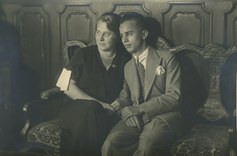
- 14 March 1935
Suse dies by suicide. The official version is that she ‘entschlief nach langer, schwerer Erkrankung infolge Herzschwäche’ (fell asleep after a long, serious illness due to heart failure). In 1939 Joachim writes a poem about her death containing the lines: “Krank ist sie nicht und leidet sehr – Weiss ich es doch und weiss noch viel mehr” (Ill she is not and she suffers a lot – don’t I know it and I know a lot more). Various factors or a combination thereof may have led to her death: an impossible love, her alcohol dependence, Ivan’s infidelity, anti-Jewish politics?
- August 1935
Ivan also moves to Ghent, where he first takes up residence at ‘Hôtel de la Poste’ at Kouter. After a half-year stay in an apartment at Patijntjestraat 16J, he moves in with his son at Schoonmeersstraat 39 on 7 July 1936. Ivan’s cousin Trude Meyerstein and her 13-year-old son Joachim Gramm are registered at the same address.
- 30 October 1935
Marcel Cocquyt, director at PEMO, sends a letter to the Ministry of Justice. Because of his intervention, father and son Esberg get to extend their temporary residence permit. Ivan’s trade in livestock is too interesting from an economic point of view. However, Ivan and Joachim are not recognized as political refugees and retain their original German nationality.
- 22 September 1937
Joachim enrolls at Ghent University. During the academic years 1937-1938 and 1938-1939 he completes his candidate degree in Germanic philology. With the start of his first licentiate degree year, Joachim serves as a study hall supervisor (presumably at PEMO) and he teaches 17 hours a week at the Atheneum at Ottogracht.
On the day of the German invasion, all men in the house at Schoonmeersstraat are arrested and brought to the prison of Ghent. On 8 May, the Ministerial Council decided that foreigners from a country with which Belgium is at war need to be expelled. The men concerned are Ivan and Joachim Esberg, Joachim Gramm, Karl Hertz (°1922) and Franz Katzenstein (°1884).
- 30 May 1940
After a long and strenuous train journey, the first arrested people arrive at the internment camp at Saint-Cyprien, located on a beach by the Mediterranean Sea. The camp was built in the spring of 1939 to receive republicans who fled to France after Franco’s victory in the Spanish Civil War.
- 29 October 1940
After the clearing of the Saint-Cyprien camp, the Esbergs end up in the Gurs camp, 450 kilometers to the west. Joachim expresses some hope in a letter: ‘Ich befürchte, dass Belgien mir keine Zukunft bietet, eher Amerika’ (I am afraid that Belgium does not offer me a future, rather America). Surveillance is initially in the hands of the Vichy government, but as soon as the Nazis put their plans for the extermination of the Jews into force, the French hand over the prisoners in Gurs to the Germans. Joachim has to abandon all hope. The deportations from Gurs start at the beginning of August 1942.
- 11 September 1942
Joachim is one of the 1,000 Jews who are deported with transport 31 from transit camp Drancy to Auschwitz. In the autumn of 1942 he meets his end.
- 1942
Ivan escapes the Gurs camp and succeeds in returning to Ghent in 1945. He reunites with Trude, who survived the camp at Auschwitz. They live together at Duifhuisstraat 32.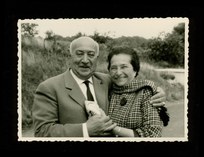
- 26 February 1947
Ivan weds Trude. They live together at Sportstraat 155 (now 145). They both spent years searching for their sons, who went missing during the war.
- 1952-1953
Willy Roggeman, student and later author, is living in lodgings at PEMO at Holstraat. In a built-in cupboard, behind a series of canned vegetables, he finds a stack of German books. Based on the ex-libris he can picture the previous owner as a Jewish woman from Wolfenbüttel. When PEMO director Marcel Cocquyt states that the books need to go, Willy Roggeman takes 74 works out of the cupboard and adds them to his own belongings. In a later diary entry he writes: ‘Ik heb de exemplaren in mijn bezit als gevonden behandeld, ik heb ze nooit als mijn eigendom beschouwd’ (I have treated the volumes as found items, I have never considered them my possessions). In 1996, Willy Roggeman writes two poems about Suse (published later in - among others - The Poems 1953-2002 from 2004).
- 6 October 1971
Trude dies. She and Ivan had been living in Residence Floréal at Frère Orbanlaan since March 1957.
- 6 February 1987
Ivan dies at the age of 101 at the Institut Moderne at Koningin Fabiolalaan. He leaves behind a bookcase with a selection of Suse’s books for a good friend, Margret Zerfass. On her regular visits, she was often reading the books while Ivan was taking an afternoon nap. In the course of the years, Margret donates a couple of books to acquaintances and friends who are interested in German literature. Many of the books that had been left at Holstraat appear to be written by contemporary authors from Suse’s time, including quite a few German-Jewish writers. The books that Margret Zerfass has at home are mainly collected works by authors active in the last decades of the 19th century – from Suse’s point of view they could be considered ‘modern classics’.
- 2008
Willy Roggeman donates his archive and a large part of his personal library to the Ghent University Library. It sparks the interest of literary scholar Jürgen Pieters in Suse and her books.
- 8 November 2019
Jürgen Pieters’s research results in the book ‘De asse waait de tuin weer binnen: de boeken van Suse Esberg’ (ASP Editions) and in the exhibition ‘De boeken van Suse Esberg’ at Vandenhove Pavilion at Rozier in Ghent.
- December 2019
Through the exhibition at Vandenhove Pavilion, researcher Jürgen Pieters meets Margret. Both him and Margret discover different aspects of the story of Suse Esberg’s books. Just before her death in the summer of 2020, 108-year-old Margret gives Suse’s bookcase (and the 58 books in it) to the Ghent University Library.
- 1 October 2020
The books that were kept by Margret all those years are reunited with those from Willy Roggeman’s donation.
Map
Collection
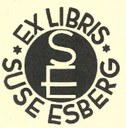
- Works from the Roggeman collection
- Works donated by Margret Zerfass
More information?
- Pieters, Jürgen. De Asse Waait De Tuin Weer Binnen. De Boeken Van Suse Esberg. Brussel: ASP, 2019.
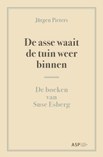
- Pieters, Jürgen. De Boeken Van Suse Esberg. Gent: Vandenhove centrum voor architectuur en kunst, 2019.
Images:
Bookcase: Nathalie Demeester
Esberg family: Marianne Steiner Collection, Leo Baeck Institute/Center for Jewish History, New York

